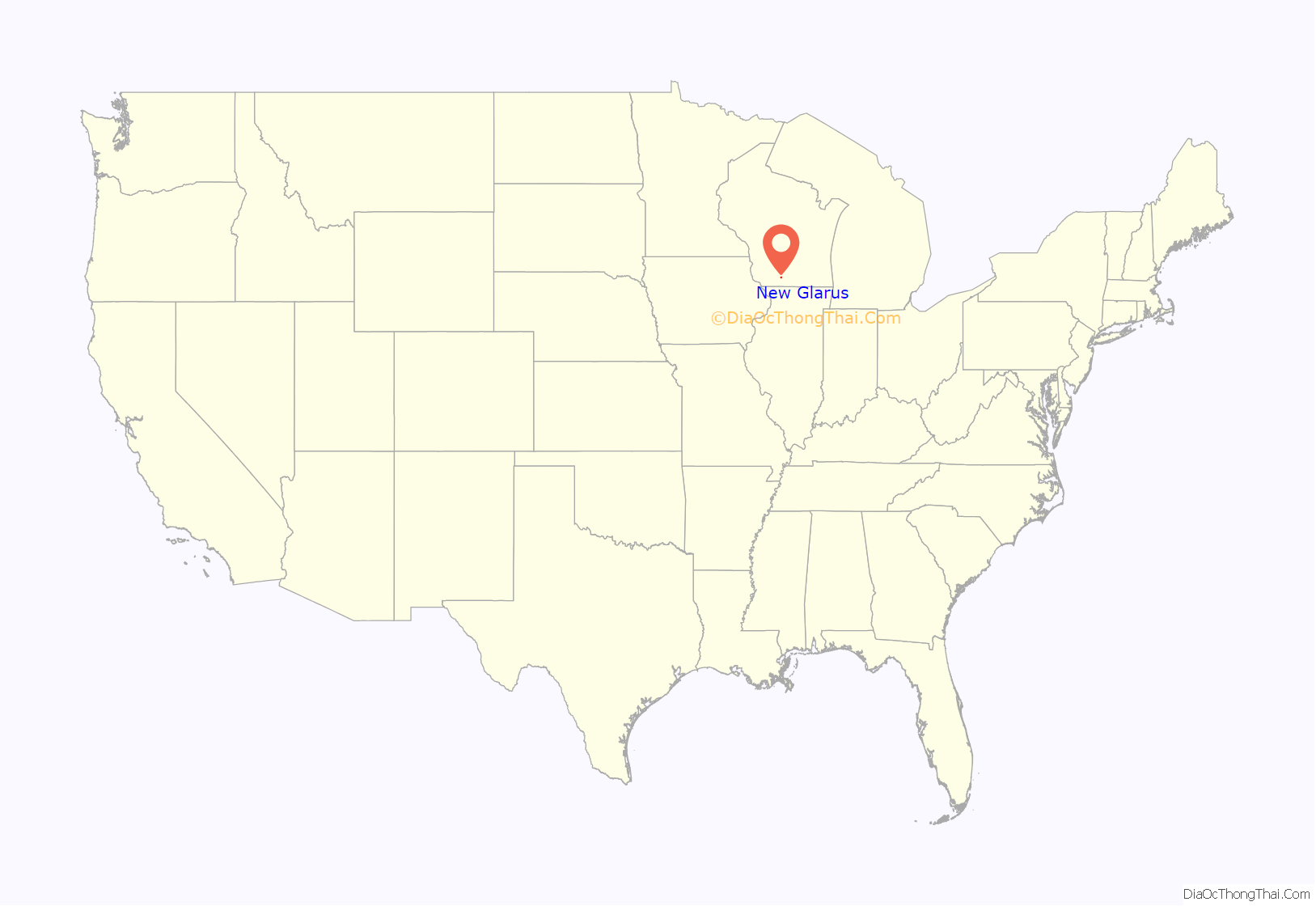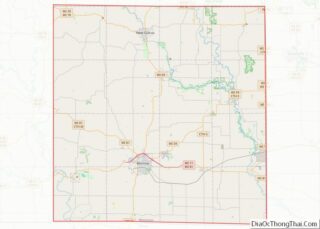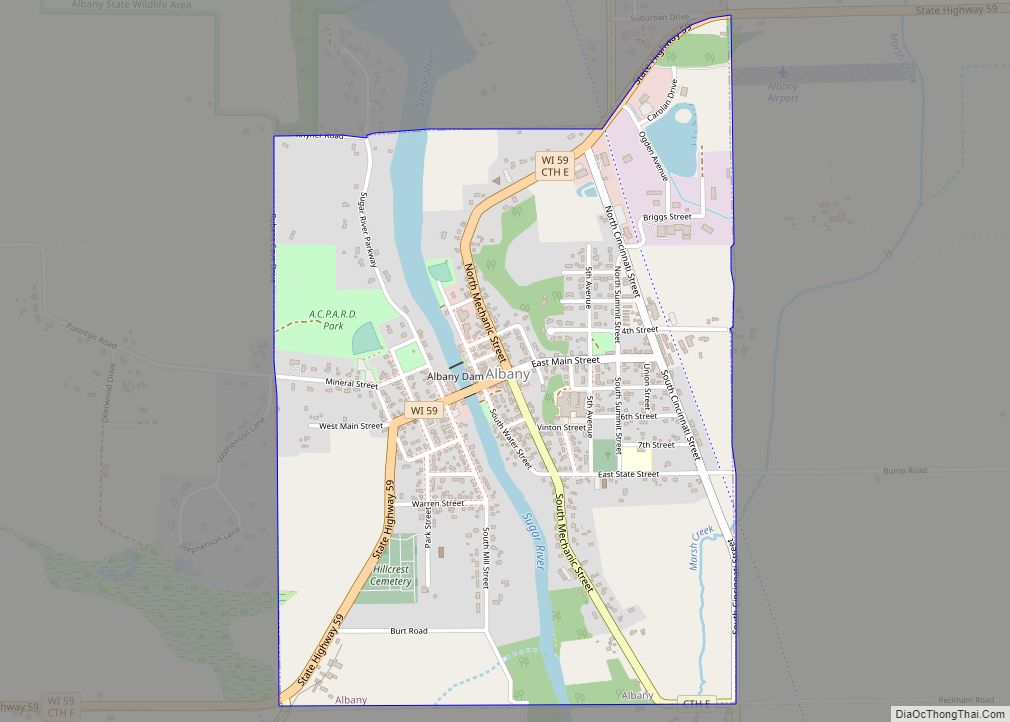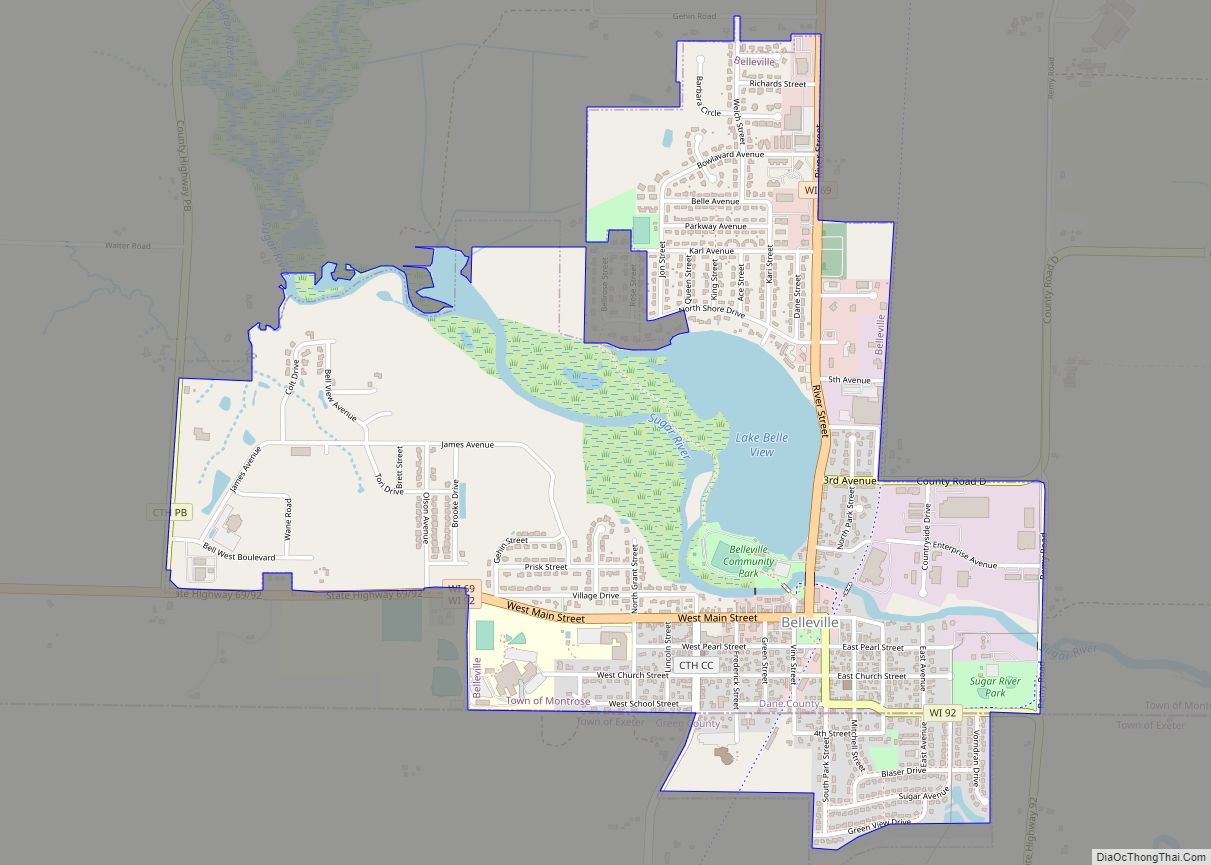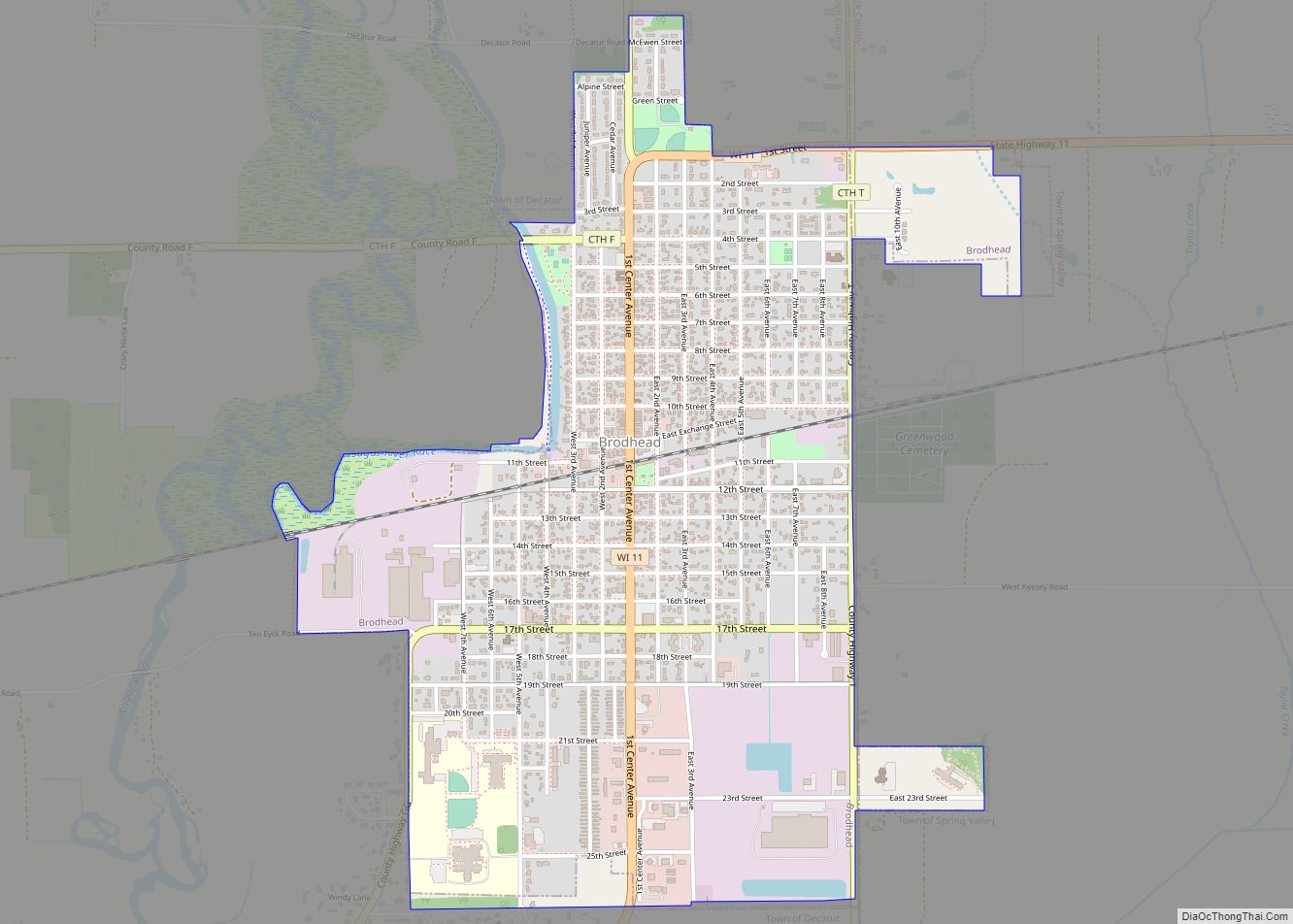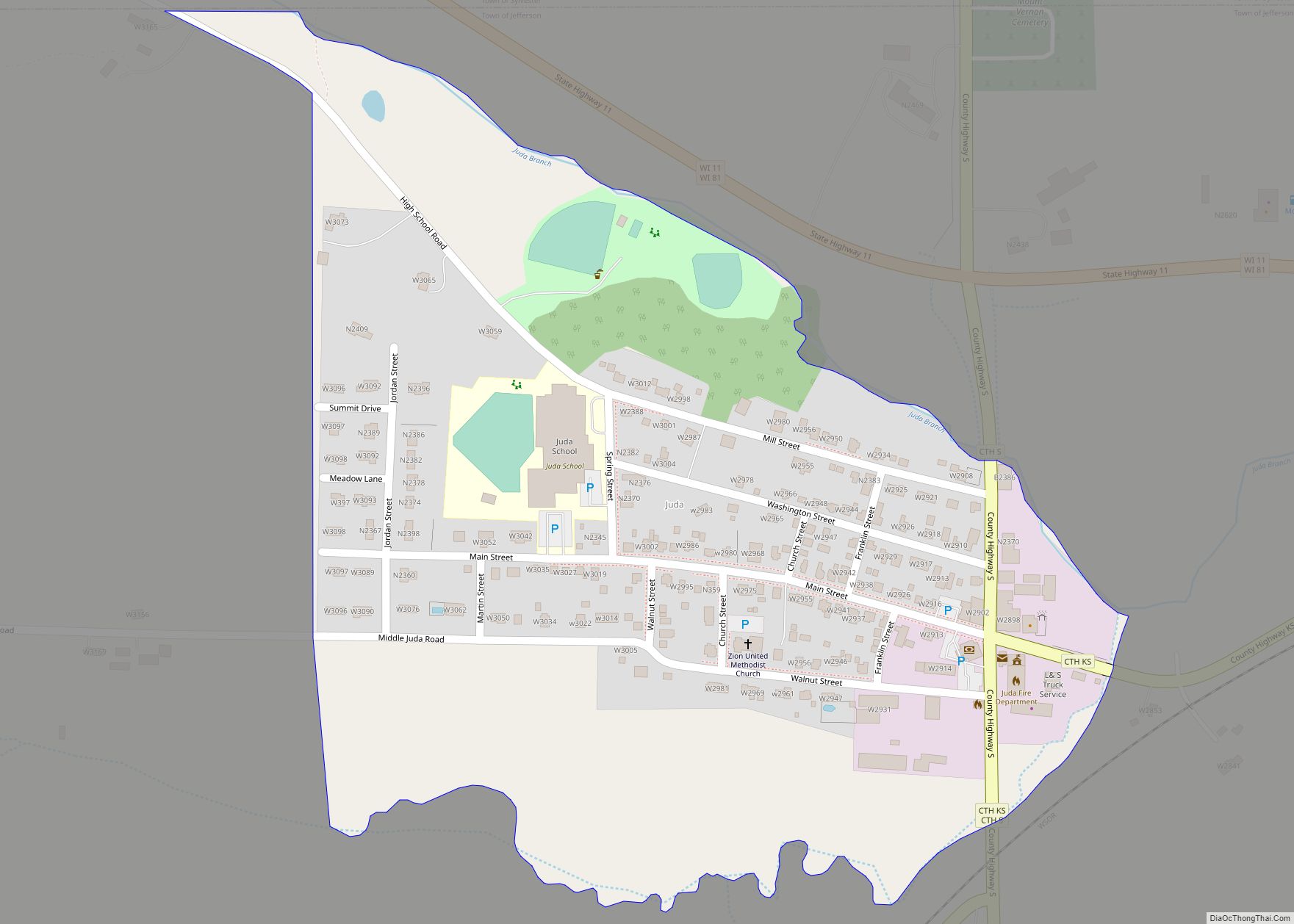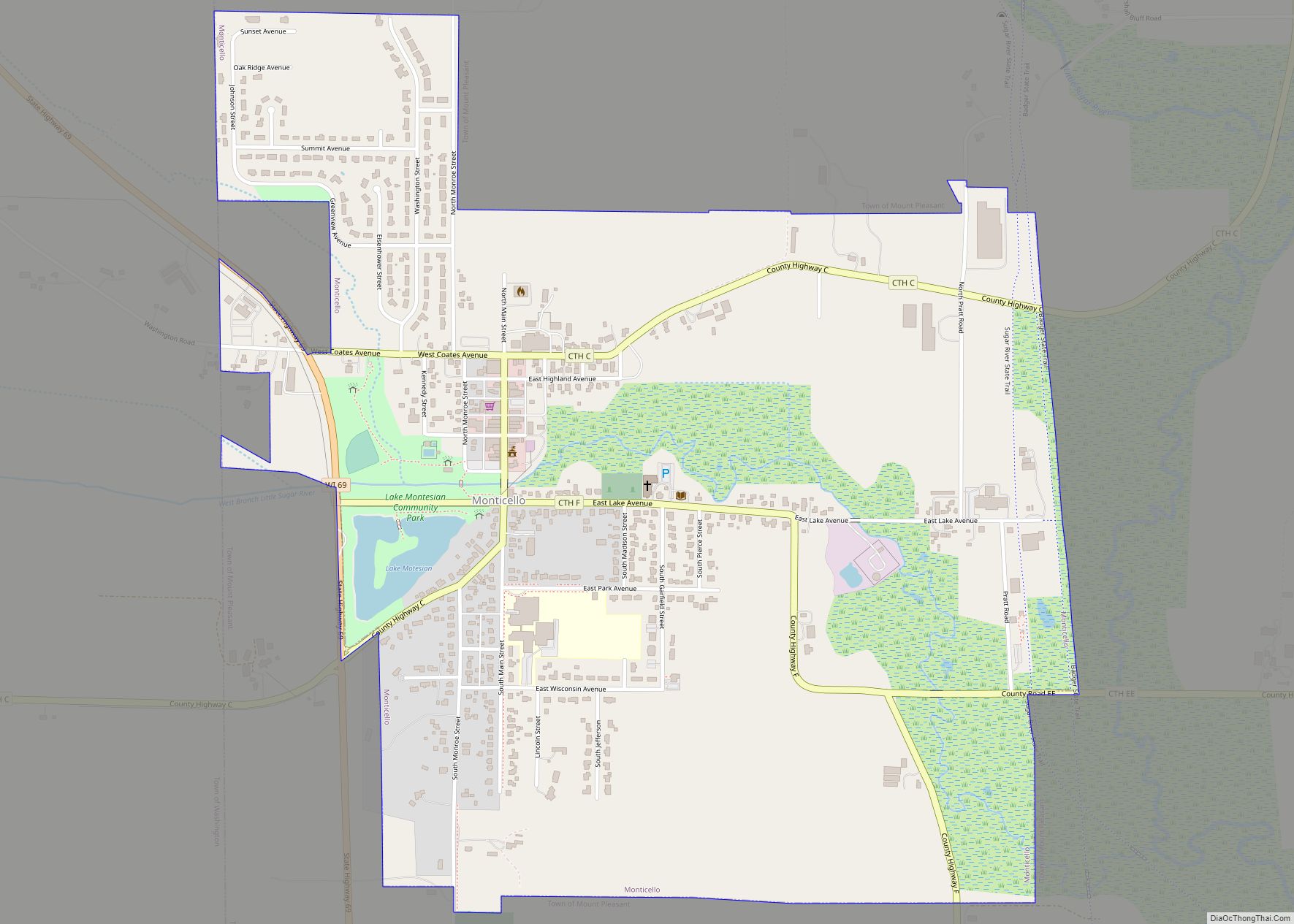New Glarus is a village in Green County, Wisconsin, United States at the intersection of Wisconsin Highways 69 and 39. It has a population of 2,266 according to the 2020 census. The village, and the town that surrounds it, were named after the canton of Glarus in eastern Switzerland. The community was founded in 1845 by immigrants from that canton and was incorporated in 1901.
| Name: | New Glarus village |
|---|---|
| LSAD Code: | 47 |
| LSAD Description: | village (suffix) |
| State: | Wisconsin |
| County: | Green County |
| Founded: | 1845 |
| Elevation: | 900 ft (274 m) |
| Total Area: | 1.80 sq mi (4.65 km²) |
| Land Area: | 1.80 sq mi (4.65 km²) |
| Water Area: | 0.00 sq mi (0.00 km²) |
| Total Population: | 2,266 |
| Population Density: | 1,261.0/sq mi (486.8/km²) |
| Area code: | 608 |
| FIPS code: | 5556700 |
| GNISfeature ID: | 1570216 |
| Website: | www.newglarusvillage.com |
Online Interactive Map
Click on ![]() to view map in "full screen" mode.
to view map in "full screen" mode.
New Glarus location map. Where is New Glarus village?
History
Coming to America
In the early 1840s, after several years of failed crops and as food became scarce, much of the canton of Glarus in Switzerland found itself deep in poverty. With more workers than available jobs, the government of the canton saw emigration to America as a solution. Authorities established the Glarus Emigration Society in 1844, which offered loans to help residents purchase land in the New World. All other expenses associated with the voyage to America were to be paid by the emigrants themselves. Men were offered 20 acres (81,000 m) free of rent for ten years, after which they could own the land for a mere ten shillings per acre. Given the desperate economic conditions in Switzerland, 193 volunteers decided to leave their homeland to start anew in America.
In 1845, magistrates in Glarus dispatched two men, Nicolas Duerst and Fridolin Streiff, to find a suitable location for a colony in the New World. They were given $2600 and instructions to purchase land, build cabins, and prepare for the settlers to arrive the following spring.
Duerst and Streiff began their search in Ohio, Indiana, and Illinois before reaching St. Louis, Missouri. In the early days of July 1845, they then traveled north to Galena, Illinois, after which they arrived at the land office in Mineral Point, Wisconsin. The men investigated several tracts of farm and timber land in the southern Wisconsin territory before deciding on two square miles along the Little Sugar River. On July 17, 1845, they purchased 1,200 acres (4.9 km) for $1.25 per acre. It was a fertile basin bounded with hills and a large stand of trees nearby. Some said later it was not the best property available, but the valley and hilltops reminded them of their native Switzerland.
The land that would become the Village of New Glarus was untamed wilderness, which had been inhabited by Native Americans for centuries. An Indian trail passed just south of present-day New Glarus, through what is now New Glarus Woods State Park. That trail later became the main thoroughfare to and from New Glarus. Even as late as 1845 the remnants of an old wigwam were still found near there.
Anxious to begin a fresh life in the New World, families in Switzerland decided to depart much earlier than expected. On April 10, 1845, the group left Glarus on a barge bound for Rotterdam. From there they expected to sail into New York City where friends were scheduled to meet them. Dishonest agents, however, routed them to Baltimore, Maryland, where they first set foot in America after a 49-day voyage. Without any knowledge of the whereabouts of Duerst and Streiff, the former residents of Glarus left Baltimore searching for the two men who arrived before them and the land chosen for their new home.
During their journey across America, the Swiss pioneers heard rumors that Duerst and Streiff had died. Undaunted, the group continued their difficult journey west. When they arrived in St. Louis, it was said that the settlers were covered with mosquito bites and very nearly approaching starvation. From St. Louis they then boarded a steamboat for Galena, Illinois.
Shortly after arriving in Galena, the settlers from Switzerland were excited to learn Duerst and Streiff were alive and had already secured land for their new settlement. Overjoyed, 18 men left that night on foot and walked 62 miles (100 km) to the location of the settlement. Wagons were then dispatched back to Galena for the remainder of the immigrants still there. After a long journey that took four months and five days, 108 settlers arrived at their new home on August 15, 1845. Three members of their party died on the way to southern Wisconsin. The balance found work or friends along the way; many more joined the colony later the following year.
The early years
In all, the New Glarus settlers purchased 1,200 acres (500 hectares) for their new home. Many of the pioneers were carpenters, mechanics, and farmers; trades that proved useful as the settlers prepared for their first winter in the Wisconsin Territory. A sum of $1,000 was used by the settlers that winter to purchase tools, cattle, seed, and other provisions, all of which had to be repaid with the price of the land within ten years of the formation of the colony. Twelve families stayed in the community’s only wooden hut that first winter, which was built on the same property where the Swiss United Church of Christ is presently located. Their diet consisted mainly of potatoes and grated cheese, a dish also known as Röschti. They also ate fish caught from the Little Sugar River. Bread, it was said, was a rarity, and meat even more so. To earn money to survive their first winter, the settlers worked in the nearby lead mines in Exeter and Mineral Point. In 1851 the first store in New Glarus opened, followed in 1853 by the first hotel, and in 1870 by the first cheese factory.
Two years after New Glarus was founded, another group of immigrants arrived from “Old Glarus.” Then, one by one, more arrived, and the population of New Glarus was reinforced by new settlers from their motherland. The 1870 census showed 1,247 natives of Switzerland living in Green County, Wisconsin. By 1878 the 22 original 20-acre (8 ha) parcels owned by the first settlers had grown to more than 30,000 acres (12,000 ha) around New Glarus.
Eventually every Swiss franc loaned to the settlers was returned to their former home in Switzerland with interest. Then in 1861 a terrible fire devastated much of the town of Glarus, the capital of the Swiss canton from which the settlers had originated. The fire destroyed 593 buildings while over 3,000 people lost their roofs and everything they owned. To aid their former countrymen back in their native homeland, the residents of New Glarus collected and dispatched more money than what they received in the form of a loan from Glarus 16 years earlier. And then 19 years after that when much of the town of Elm, also in the canton of Glarus, was buried beneath a landslide killing 114 people, the residents of New Glarus rushed to help again: this time sending $20,000 back to the old country.
Though they had only been residents in America a very short time, 98 Glarners fought for the Union during the American Civil War. The residents of tiny New Glarus contributed to other American wars, too. The Swiss Miss Textile Mart and Lace Factory in New Glarus made chevrons and insignia for U.S. military uniforms during World War II. Walter Gabriel Schindler, who was born in New Glarus, fought in that same war and received the Navy Cross and Silver Star. Kevin Patrick Lynch from New Glarus also received the Navy Cross in World War II. In 2001, Henry Janisch, a native of New Glarus, became “one of the first Marine(s) off the first helicopter” in the opening moments of the War in Afghanistan.
Agriculture
After their first winter in the New World, the residents of New Glarus purchased cattle from Ohio at $12 a head. This stock was the birth of dairy farming and cheese making in New Glarus, a trade many had learned from their fathers and forefathers in Switzerland. Soon the herds of dairy cows in and around New Glarus swelled and dairy products proved lucrative.
Nickolaus Gerber, who moved from New York, started the first cheese factories in New Glarus, beginning with the area’s first Limburger cheese factory four miles (6 km) southwest of New Glarus. He later built America’s first Swiss cheese (also known as Emmental in Switzerland) factory on the Dietrich Freitag farm outside of New Glarus in Washington township.
Following the end of the Civil War, and with the evolution of the cheese production, the prosperity of New Glarus and neighboring communities grew. At its peak in 1905, New Glarus boasted 22 cheese factories; so many it was said the crossroads of the town were congested with daily deliveries of milk to the Limburger and Swiss cheese factories. New Glarus quickly became known as the “Cheese Capital of the World.” Today only one Limburger cheese factory remains near New Glarus; the last of its kind in all of North America. Despite declining popularity of Limburger cheese, the area around New Glarus still boasts the largest concentration of specialty cheese factories and award-winning cheesemakers anywhere in the United States.
In 1910 Helvetia Milk Condensing Company, of Highland, Illinois, opened a factory New Glarus to make sweetened condensed milk. It quickly became the village’s largest employer. It bought large quantities of milk from farms in the area, and as a result, most of the local cheese factories closed. In 1923, the Helvetia Milk Condensing was renamed the Pet Milk Company. In 1962 Pet Milk Company closed its condensing plant in New Glarus, forever changing the fabric of the small town. Agricultural-based businesses, once integral to the New Glarus economy, disappeared. Cheese factories, farm equipment dealerships, feed mills, hardware stores, and other businesses that profited from local agribusiness were soon gone. But the plant’s closure also spurred the development of tourism as a new source of income for New Glarus, as it promoted the village’s ethnic history as a Swiss colony.
New Glarus Road Map
New Glarus city Satellite Map
Geography
According to the United States Census Bureau, the village has a total area of 1.8 square miles (4.66 km), all land. New Glarus is included in the Madison Metropolitan Statistical Area.
See also
Map of Wisconsin State and its subdivision:- Adams
- Ashland
- Barron
- Bayfield
- Brown
- Buffalo
- Burnett
- Calumet
- Chippewa
- Clark
- Columbia
- Crawford
- Dane
- Dodge
- Door
- Douglas
- Dunn
- Eau Claire
- Florence
- Fond du Lac
- Forest
- Grant
- Green
- Green Lake
- Iowa
- Iron
- Jackson
- Jefferson
- Juneau
- Kenosha
- Kewaunee
- La Crosse
- Lafayette
- Lake Michigan
- Lake Superior
- Langlade
- Lincoln
- Manitowoc
- Marathon
- Marinette
- Marquette
- Menominee
- Milwaukee
- Monroe
- Oconto
- Oneida
- Outagamie
- Ozaukee
- Pepin
- Pierce
- Polk
- Portage
- Price
- Racine
- Richland
- Rock
- Rusk
- Saint Croix
- Sauk
- Sawyer
- Shawano
- Sheboygan
- Taylor
- Trempealeau
- Vernon
- Vilas
- Walworth
- Washburn
- Washington
- Waukesha
- Waupaca
- Waushara
- Winnebago
- Wood
- Alabama
- Alaska
- Arizona
- Arkansas
- California
- Colorado
- Connecticut
- Delaware
- District of Columbia
- Florida
- Georgia
- Hawaii
- Idaho
- Illinois
- Indiana
- Iowa
- Kansas
- Kentucky
- Louisiana
- Maine
- Maryland
- Massachusetts
- Michigan
- Minnesota
- Mississippi
- Missouri
- Montana
- Nebraska
- Nevada
- New Hampshire
- New Jersey
- New Mexico
- New York
- North Carolina
- North Dakota
- Ohio
- Oklahoma
- Oregon
- Pennsylvania
- Rhode Island
- South Carolina
- South Dakota
- Tennessee
- Texas
- Utah
- Vermont
- Virginia
- Washington
- West Virginia
- Wisconsin
- Wyoming
